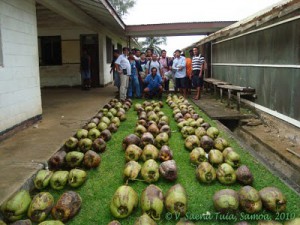A heart-warming story from BBC News: in the village of Dharhara in India, parents plant 10 or more fruit trees when a baby girl is born. The trees mature slightly faster than the girls, and by the time a girl is nubile the profits from the sale of fruit is more than enough to pay the bride price commonly required by the groom’s family. Bihar has the highest death rate among families who cannot pay a bride price. But not in Dharhara.
Nibbles: Allium, Desertification and livestock, Striga, Emmer, Hawaii, Almond, Seeds at FAO, Cassava in central Africa, Seed sculpture, Biofortification, Millets, Lunatrick pea
- Botany Photo of the Day is an onion wild relative! Pretty.
- More on that livestock-can-help-reduce-desertification thing, this time from Scientific American.
- Breeding Striga-resistant sorghum. Whatever it takes to protect local beer, boffin-dudes!
- Emmer wheat reviewed to bits.
- No passport data for your barley? Fear not.
- Rachel Laudan ably defends Hawaiian food.
- Origins of almond traced to Iran. Not for the first time.
- Plant Genetic Resources for Food and Agriculture: A Commons Perspective. Presentation from our friends at FAO.
- Presentation on the untapped potential of cassava in the Great Lakes region of Africa. One of many from CIAT lately. Check out their stuff on beans too.
- The Seed Cathedral of Shanghai. Thanks to those public awareness wizards at Kew.
- Big shindig on biofortification. Be there, or be malnourished.
- Times of India bangs the drum for nutritious millets.
- Yet more loveliness from serious amateur pea breeder Rebsie Fairholm.
Nibbles: Niu kafa, Rice origins, Monsanto seed donation, Soils, Red junglefowl
- More on Roland’s quest for the biggest coconut in the world.
- Rice cultivation in Lower Yangtze dates back to 6th millennium, and took a millennium to establish itself.
- Yet more on Haiti’s “hybrid hate.”
- Soil scientist says soils are important.
- “ARKive is creating the ultimate multimedia guide to the world’s endangered species”: including a wild relative or two.
Looking for Niu Afa
You have been following the Adventures of Roland in Samoa, have you not?

Nibbles: Ecosystem vulnerability, Mayan chocolate, Natural dyes, Japanese art
- Climate change affecting ecosystems. Well I never. Mashup with crop wild relative distributions needed!
- Hershey scientist studies ancient chocolate.
- Natural dyes in Indonesia. Temptation to pun successfully resisted for once.
- Agrobiodiversity in art: The Old Plum.